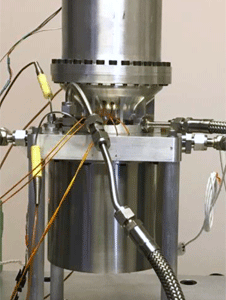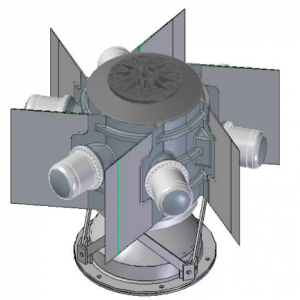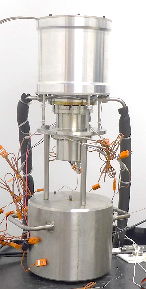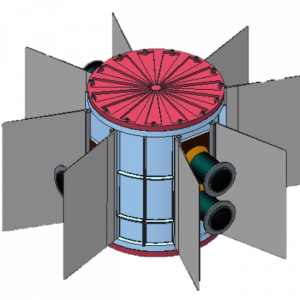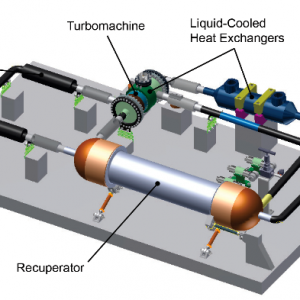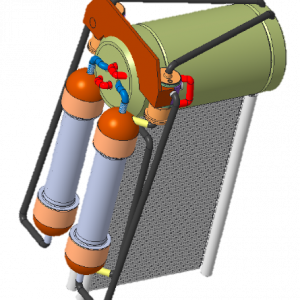Dynamic Radioisotope Power Systems (DRPS)
NASA Glenn Research Center (GRC) is supporting the development of dynamic power convertors for future Radioisotope Power Systems (RPS). NASA’s RPS Program, through the Dynamic RPS (DRPS) Project, seeks to mature dynamic power convertor prototypes that are reliable, robust, and highly efficient to support future flight RPS generator development.
The DRPS project is initiating a new chapter of technology maturation of high-efficiency dynamic power convertor technologies. Three convertor development contracts supporting this effort are currently underway. Two of the contracts are focused on Stirling-cycle machines, and another is pursuing Brayton conversion.
The contracts consist of three phases: Design, Fabrication, and Test. The 2017 design phase was followed by fabrication of the convertor prototypes, where assembly and production testing are being completed to demonstrate functionality prior to delivery to GRC.
Upon delivery, the prototypes will undergo validation and verification (V&V) testing at NASA facilities, including acceptance testing, performance verification, and environmental testing. The environmental testing simulates the harsh conditions that are anticipated during a science mission, including random vibration to simulate the launch sequence and centrifuge testing to simulate static loads anticipated during decent and landing on a planetary surface. A discussion of each of the three contracts is given below.
As of October 2020, Sunpower, one of the three DRPS contractors, has completed the fabrication phase and has delivered two Stirling convertor prototypes to GRC. AMSC is nearing completion of two Stirling convertors with anticipated delivery at the end of 2020. Creare continues to work on production of the Brayton prototype with anticipated completion in early 2021. In addition to the on-going extended operation of several older long-lived Stirling convertors, GRC’s Stirling Research Laboratory is being upgraded to conduct key testing of these DRPS convertor prototypes. In addition to performance testing and extended operation, launch vibration simulation testing and centrifuge testing is planned.
Flexure Isotope Stirling Convertor (FISC)
The FISC prototype concept is being developed by American Superconductor (AMSC) of Richland, WA. The FISC prototype is based on the Technology Demonstration Convertor (TDC), developed during the 110W Stirling Radioisotope Generator (SRG-110) flight development project. It includes changes that improve performance, reduce mass, and improve manufacturability, compared to the TDC.
A total of 16 TDC prototypes and two engineering units were produced during the flight contract, between 2000-2006. The four longest running TDCs have accumulated over 53 years of operation and TDC #13 is currently the longest running heat engine in the world with over 14 years of operation. It was paired to TDC #14, which was disassembled and inspected after 12 years of error-free operation to document the state of the internal surfaces. No unanticipated observations were made which successfully demonstrated the long life design.
While the TDC and FISC designs both employ flexure bearings to maintain non-contacting running clearances needed for wear-free operation, some aspects were changed to improve upon the TDC design. The FISC employs a moving-magnet alternator instead of the previous moving-iron design and the engine contains new alignment features that help streamline assembly. The prototype design is non-hermetic to permit disassembly and inspection during the government verification and validation (V&V) testing.
The FISC generator concept was developed by Teledyne Energy Systems, Inc. with support from AMSC. The concept contains a centrally located stack of four General Purpose Heat Sources (GPHS) modules, surrounded by radiatively-coupled convertors. There are six convertors installed and four required for full power operation, making two convertors redundant. Each pair of convertors are electrically synchronized for dynamic balancing. With a focus on modularity, the FISC generator concept could utilize 2, 3, or 4 GPHS step-2 modules, providing a beginning of life power output of 107, 176, and 237 W, respectively. The heat rejection exchanger is integral to the generator housing radiator surface, improving heat rejection while requiring separate engine and alternator attachment during integration into the housing.
Sunpower Robust Stirling Convertor (SRSC)
The SRSC prototype is being developed by Sunpower Inc. of Athens, OH. The SRSC prototype is based on the Advanced Stirling Convertor (ASC) from the Advanced Stirling Radioisotope Generator (ASRG) flight development project. It includes changes that improve robustness and ease startup, compared to the ASC. A total of 17 ASC prototypes and 20 engineering units were produced between 2007-2015.
GRC continues to operate four ASC in extended operation and they have accumulated over 30 years of operation. ASC-0 #3 is currently the longest running ASC with over 10 years of operation and ASC-L has accumulated over 6 years of operation while under control of the Single Convertor Controller (SCC), developed by the Applied Physics Laboratory. Disassembly and inspection of some units was used to identify needed improvements for thermal stability of running clearances and robustness to over-test conditions.
While the ASC and SRSC designs use gas bearings to maintain non-contacting running clearances needed for wear-free operation, changes were made to increase the stiffness of the bearings and improve robustness. It employs a robust regenerator design to eliminate the risk of debris generation and has incorporated a passive collision prevention system, in case of temporary loss of electrical load, that dissipates thermodynamic cycle energy for a portion of the cycle where the moving components exceed a threshold amplitude.
The SRSC generator concept was developed by Aerojet Rocketdyne with support from Sunpower. The generator contains a centrally located stack of four GPHS modules surrounded by radiatively-coupled convertors. There are six convertors installed and four required for full power, making two convertors redundant. Each pair of convertors are electrically synchronized for dynamic balancing. The convertor heat rejection flange is bolted to the generator housing fin assembly.
Turbo-Brayton Convertor (TBC)
The TBC prototype design was developed by Creare Inc. of Hanover, NH. The TBC prototype design builds off of previous projects, such as their RPS-sized design from a 2002 research announcement and NASA SBIRs. It includes changes that improve bearing performance and increase temperature tolerance to accommodate DRPS requirements.
The TBC prototype uses hydrodynamic journal bearings and thrust bearings to maintain non-contacting running clearances needed for wear-free operation. Creare has previously demonstrated hydrodynamic gas bearings and close clearance seals of this size on previous projects, notably the cryocooler on Hubble’s Near Infrared Camera and Multi-Object Spectrometer (NICMOS) instrument. The turbo machine consists of a single rotating shaft with turbine and compressor impellers located at each end. The shaft contains a rare-earth magnet which rotates inside a stationary coil and iron of the rotary alternator. The conversion process is enabled by unidirectional gas flow through the turbomachine assembly, recuperator, and heat exchangers. The counter-flow recuperator enables high thermodynamic efficiency by pre-warming gas before it flows into the heat source assembly.
The TBC generator concept was developed by Aerojet Rocketdyne and Creare with support from West Coast Solutions. The concept takes inspiration from the 1990’s Dynamic Isotope Power System (DIPS) concept from Rocketdyne and Allied Signal. The TBC generator concept contains two convertors to provide full redundancy and enable counter-rotating turbo-alternators so no net angular momentum would be imparted into the space vehicle with both convertors operating. While both convertors share the heat source assembly, each convertor contains a turbomachine, recuperator, and a radiator with a high surface area.

